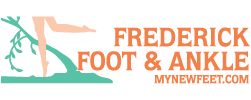In the picture above is Abby with Dr. Steinberg. Abby, a French Poodle, is such a smart service dog that she is even able to remove shoes and socks on command.
Service Dogs occasionally make their way into the Frederick Foot & Ankle office. Not only do their owners benefit from their presence but our staff enjoys their company as well. Service dogs are normally distinguished by a tag or a vest, to inform the surrounding population that they are working. Service dogs are trained specifically for one individual and the conditions the individual needs assistance with. Americans with Disabilities Act (ADA) allows service dogs to enter places that are for the public, this provides the service dog’s owner to continue their daily activities with the help of their trained companions. Although we have not yet seen one yet at Frederick Foot & Ankle the ADA also recognizes miniature horses for their service assistant.
Apart from Service dogs there are also therapy animals and emotional support animals. Therapy animals are normally canine and are trained to comfort a large population such as those in nursing homes, schools, or hospitals. The therapy animals help alleviates negative feelings associated with anxiety, depression, and other mental disorders. Emotional Support Animals are another category of animals that aid their human in daily life. Emotional supports animals do not need any specific training because just their presence helps their companion with mental stresses. Although these therapy animals and emotional support animals are helpful in multiple settings they are not granted the same rights as service dogs.
Research for pet therapy has presented the medical community with many beneficial effects
- Decreased the severity of “sundowner” symptoms in dementia patients
- Alzheimer patients reported recalling more memories
- Those with PTSD felt a reduction in symptoms
- Diabetics where alerted when their blood sugar was dangerously low
- Helping those with drug addiction not feel alone and consider their pets feelings and not just their own
We love our diverse population of patients and feel so lucky to witness the true healing power of their furry friends.
( #Exercise #School #September #Study #Grades #Food #Sleep #Test )
